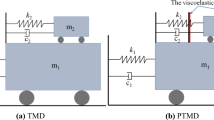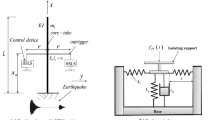Abstract
Purpose
This study is an attempt to illustrate and discuss multi-hazard interactions in vibration control of long-span bridges subjected to wind and seismic loads. Such bridges, being flexible structures, are inherently vulnerable to wind loads. However, some response parameters of such bridges, for example, tower and deck acceleration, can be significant during large earthquakes which produce ground motions with low-frequency content.
Methods
To illustrate this problem, a case study of the Runyang Suspension Bridge (RSB) is used. A finite element model of the bridge is created and verified against published literature. A set of ground motions from large worldwide earthquakes and spatially varying wind velocity time series, simulated as a realization of a random field, are used to evaluate the bridge's dynamic response with and without control devices. The control devices applied in this study are passive-tuned mass dampers (TMDs). Careful investigation of the uncontrolled response of the bridge shows that while wind load is mainly important for the displacement of the bridge deck, seismic loads can induce significant acceleration of the tower and the deck. Since the response of the tower and the deck are coupled at some higher modes of vibration, seismic action, although most critical for the tower, is also relevant for deck acceleration. These observations indicate the need for a multi-performance-based control strategy.
Results
It is found that TMDs optimal for reducing seismic-induced deck acceleration can lead to amplification of wind-induced deck displacement. At the same time, TMDs optimal for reducing wind-induced displacement response are, in some cases, harmful to seismic-induced deck acceleration. These results clearly show multi-hazard interaction in control performance.
Conclusions
To account for this problem, a control strategy for the deck and tower's seismic and wind responses is investigated. This consists of TMDs placed at the top of each tower and 4 TMDs placed on the deck. By tuning the TMDs to different vibration modes of the bridge, the system is shown to be effective for both seismic and wind actions.










Similar content being viewed by others


Data availability
The data used in this study can be obtained by contacting the corresponding author.
References
AfifChaouch K, Tiliouine B, Hammoutene M, Sigbjörnsson R, Rupakhety R (2016) Estimating ground motion incoherence through finite source simulation: a case study of the 1980 El-Asnam Earthquake. Bull Earthq Eng 14(4):1195–1217
Aly AM (2014) Vibration control of high-rise buildings for wind: a robust passive and active tuned mass damper. Smart Struct Syst 13(3):473–500
Ancheta TD, Darragh RB, Stewart JP, Seyhan E, Silva WJ, Chiou BS et al (2013) Peer nga-west2 database. Available online at http://peer.berkeley.edu/ngawest2/databases/. Last Accessed Dec 2021
Arioli G, Gazzola F (2013) Old and new explanations of the Tacoma Narrows Bridge collapse. In: Atti XXI Congresso AIMETA, Torino, p 10
Cai CS, Chen SR (2004) Wind vibration mitigation of long-span bridges in hurricanes. J Sound Vib 274(1):421–432
Chen SR, Cai CS, Gu M, Chang CC (2003) Optimal variables of TMDs for multi-mode buffeting control of long-span bridges. Wind Struct 6(5):387–402
Cheynet E (2020) Wind field simulation (the fast version). Zenodo. https://doi.org/10.5281/ZENODO.3774136
Den Hartog JP (1956) Mechanical vibrations, 4th edn. McGraw-Hill, New York
Elias S, Rupakhety R, De Domenico D, Olafsson S (2021) Seismic response control of bridges with nonlinear tuned vibration absorbers. Structures, vol 34. Elsevier, Amsterdam, pp 262–274
Fujino Y (2002) Vibration, control and monitoring of long-span bridges—recent research, developments and practice in Japan. J Constr Steel Res 58(1):71–97
Fujino Y, Siringoringo D (2013) Vibration mechanisms and controls of long-span bridges: a review. Struct Eng Int 23(3):248–268
Gu M, Chang CC, Wu W, Xiang HF (1998) Increase of critical flutter wind speed of long-span bridges using tuned mass dampers. J Wind Eng Ind Aerodyn 73(2):111–123
Gu M, Chen SR, Chang CC (2002) Control of wind-induced vibrations of long-span bridges by semi-active lever-type TMD. J Wind Eng Ind Aerodyn 90(2):111–126
Ha DH, Park JH, Park KS, Park W, Choo JF (2010) Optimization of complex dampers for the improvement of seismic performance of long-span bridges. KSCE J Civ Eng 14(1):33–40
Jami M, Rupakhety R, Elias S, Bessason B, Snæbjörnsson JT (2022) Recent advancement in assessment and control of structures under multi-hazard. Appl Sci 12(10):5118
Jangid RS (2022) Seismic performance assessment of clutching inerter damper for isolated bridges. Pract Period Struct Des Constr 27(2):04021078
Ji L, Zhong J (2006) Runyang Suspension Bridge over the Yangtze river. Struct Eng Int 16(3):194–199
Kaimal JC, Wyngaard JCJ, Izumi Y, Coté OR (1972) Spectral characteristics of surface-layer turbulence. Q J R Meteorol Soc 98(417):563–589
Lavasani SHH, Alizadeh H, Doroudi R, Homami P (2020) Vibration control of suspension bridge due to vertical ground motions. Adv Struct Eng 23(12):2626–2641
Li Z, Li A, Zhang J (2010) Effect of boundary conditions on modal parameters of the Run Yang suspension bridge. Smart Struct Syst 6(8):905–920
Marić MK, Ivanković AM, Srbić M, Skokandić D (2022) Assessment of performance indicators of a large-span reinforced concrete arch bridge in a multi-hazard environment. Buildings 12(7):1046
Padgett JE, Kameshwar S (2016) Supporting life cycle management of bridges through multi-hazard reliability and risk assessment. Multi-hazard approaches to civil infrastructure engineering. Springer, Cham, pp 41–58
Paultre P, Chaallal O, Proulx J (1992) Bridge dynamics and dynamic amplification factors—a review of analytical and experimental findings. Can J Civ Eng 19(2):260–278
Pisal AY, Jangid RS (2016) Vibration control of bridge subjected to multi-axle vehicle using multiple tuned mass friction dampers. Int J Adv Struct Eng (IJASE) 8:213–227
Pourzeynali S, Estaki S (2009) Optimization of the TMD parameters to suppress the vertical vibrations of suspension bridges subjected to earthquake excitations
Rupakhety R, Sigbjörnsson R (2012) Spatial variability of strong ground motion: novel system-based technique applying parametric time series modelling. Bull Earthq Eng 10(4):1193–1204
Sadek F, Mohraz B, Taylor AW, Chung RM (1997) A method of estimating the parameters of tuned mass dampers for seismic applications. Earthq Eng Struct Dynam 26(6):617–635
Saha P, Jangid RS (2009) Seismic control of benchmark cable-stayed bridge using passive hybrid systems. IES J Part A Civ Struct Eng 2(1):1–16
Shinozuka M, Deodatis G (1991) Simulation of stochastic processes by spectral representation
Shum KM, Xu YL, Guo WH (2008) Wind-induced vibration control of long span cable-stayed bridges using multiple pressurized tuned liquid column dampers. J Wind Eng Ind Aerodyn 96(2):166–192
Simpson RH (1998) The Mycenaean highways. Echos du monde classique Class views 42(2):239–260
Soneji BB, Jangid RS (2006) Effectiveness of seismic isolation for cable-stayed bridges. Int J Struct Stab Dyn 6(01):77–96
Soneji BB, Jangid RS (2007) Passive hybrid systems for earthquake protection of cable-stayed bridge. Eng Struct 29(1):57–70
Tanida K (2002) Progress in the application of active vibration control technologies to long-span bridges in Japan. Prog Struct Mat Eng 4(4):363–371
Wang H, Guo T, Tao TY, Li AQ (2016) Study on wind characteristics of Runyang Suspension Bridge based on long-term monitored data. Int J Struct Stab Dyn 16(04):1640019
Wang H, Li A, Jiao C, Spencer BF (2010) Damper placement for seismic control of super-long-span suspension bridges based on the first-order optimization method. Sci China Technol Sci 53(7):2008–2014
Wang J, Cheynet E, Snæbjörnsson JÞ, Jakobsen JB (2018) Coupled aerodynamic and hydrodynamic response of a long span bridge suspended from floating towers. J Wind Eng Ind Aerodyn 177:19–31
Xing C, Wang H, Li A, Xu Y (2014) Study on wind-induced vibration control of a long-span cable-stayed bridge using TMD-type counterweight. J Bridg Eng 19(1):141–148
Xu K, Bi K, Ge Y, Zhao L, Han Q, Du X (2020) Performance evaluation of inerter-based dampers for vortex-induced vibration control of long-span bridges: a comparative study. Struct Control Health Monit 27(6):e2529
Xu K, Bi K, Han Q, Li X, Du X (2019) Using tuned mass damper inerter to mitigate vortex-induced vibration of long-span bridges: analytical study. Eng Struct 182:101–111
Xu K, Dai Q, Bi K, Fang G, Zhao L (2022) Multi-mode vortex-induced vibration control of long-span bridges by using distributed tuned mass damper inerters (DTMDIs). J Wind Eng Ind Aerodyn 224:104970
Zerva A (2016) Spatial variation of seismic ground motions: modeling and engineering applications. CRC Press, Boca Raton
Zhang X (2007) Influence of some factors on the aerodynamic behavior of long-span suspension bridges. J Wind Eng Ind Aerodyn 95(3):149–164
Zhu J, Zhang W, Zheng KF, Li HG (2016) Seismic design of a long-span cable-stayed bridge with fluid viscous dampers. Pract Period Struct Des Constr 21(1):04015006
Funding
Matin Jami is supported by a doctoral grant from the University of Iceland and a research grant from Vegagerðin, the Icelandic Road Administration. Rajesh Rupakhety acknowledges support from the University of Iceland Research Fund.
Author information
Authors and Affiliations
Corresponding authors
Additional information
Publisher's Note
Springer Nature remains neutral with regard to jurisdictional claims in published maps and institutional affiliations.
Rights and permissions
Springer Nature or its licensor (e.g. a society or other partner) holds exclusive rights to this article under a publishing agreement with the author(s) or other rightsholder(s); author self-archiving of the accepted manuscript version of this article is solely governed by the terms of such publishing agreement and applicable law.
About this article
Cite this article
Jami, M., Rupakhety, R., Bessason, B. et al. Multimode Vibration Control Strategies of Long-Span Bridges Subjected to Multi-hazard: A Case Study of the Runyang Suspension Bridge. J. Vib. Eng. Technol. 12, 4867–4880 (2024). https://doi.org/10.1007/s42417-023-01157-3
Received:
Revised:
Accepted:
Published:
Issue Date:
DOI: https://doi.org/10.1007/s42417-023-01157-3


